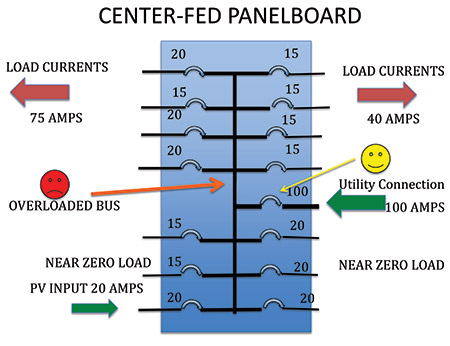I did some digging into the code making that went into the changes for the 120% rule in the 2008 NEC. It seems that initially the goal was to have 200% but they scaled it back to 120% with the intention that testing would be performed to determine if 200% would be a reasonable value. As far as I can tell this testing has not occurred, or if it was I have not found any results published.
Here was the TCC's proposed wording which would have allowed 200%:
690.64(C)(7) Bus or Conductor Rating. Unless the panelboard is rated not less than the sum of the ampere ratings of all overcurrent devices supplying it, a connection in a panelboard shall be positioned at the opposite (load) end from the input feeder location or main circuit location. A permanent warning label shall be applied to the distribution equipment with the following or equivalent wording:
WARNING
PHOTOVOLTAIC SYSTEM SOURCE OUTPUT
DO NOT RELOCATE THIS OVERCURRENT DEVICE
Here is the substantiation the TCC provided for the change. The highlights are mine.
Although the Technical Correlating Committee requested that CMP-9 comment on Proposal 13-61, and by this comment the panel has done so, the technical issues raised in that and in the associated proposals apply to all systems capable of interconnection and parallel operation using multiple sources. For this reason, CMP-9 believes that the CMP-13 actions in Articles 690, 692, and 705 must be correlated in this respect, and is providing comments to the comparable proposals and panel actions in all of these articles. In addition, the layout and content of this comment reflect a consistency of approach that assures correlation with the corresponding language in Articles 692 and 705.
CMP-9 agrees that it is possible to assure that the busbars of panelboards receiving supply current from two sources can be arranged so the busbars will not exceed their ampacity (the “opposite end” scenario accepted under this proposal), however, CMP-9 points out that such an arrangement allows for up to double the amount of load to be taken from the panel for indefinite periods of time. Current product standards do not anticipate the effect of I2R heating losses under these conditions, which could severely impact the performance of essential components within the distribution equipment. Before the NEC recognizes this type of connection, it is essential that careful testing be carried out to determine the acceptable parameters that should be applied in these cases.
For example, if a large PV system provides 100 amperes of power to a panel in an interactive system rated 100 amperes, and this panel is supplied by a normal utility supply of 100 amperes, the branch circuit and feeder loads supplied by this panel could total 200 amperes. Although such a load should not exist due to required sizing rules relative to Article 220 calculations, the requirement for individual protection for panelboards (now set to apply to all panelboards by virtue of CMP-9 action in this cycle) anticipates that these load calculations are easily circumvented given the relative ease of circuit modifications.
CMP-9 is suggesting revisions to the backfeed allowance that more closely track the actual provision in Article 408 that is intended to be varied in this Chapter 6 article. Our wording also omits the deadfront clamping language in the proposal because such construction is clearly required by the product standard and pointless here; furthermore, the deadfront does not actually “clamp all circuit breakers to the panelboard busbars.” In addition, we are offering a different version of the fine print note to address concerns raised in the voting. CMP-9 understands that CMP-13 was using the term (identified) in its Article 100 sense and not in the sense of a marking, however, this wording avoids any confusion. Other changes are editorial and in the interest of correlation, where technically appropriate, with other interactive articles.
CMP-9 expresses its willingness to assign a task group to work with CMP-13 and other industry parties to provide a carefully substantiated global approach to double-fed distribution equipment applied in interactive settings for the 2011 NEC. This might include specially targeted allowances for equipment listings that would cover such interconnections. In the mean time, this comment does broaden the 120 percent allowance from dwellings to all occupancies. Because of the I2R relationship, an allowance for an an additional 20% loading (one fifth) would only increase the heating losses by 4% (one twenty fifth), which should be tolerated by existing equipment designs even if the interconnection does not occur at the opposite end of the bus from the normal supply. This comment incorporates the opposite-end rule from the CMP-13 action on this proposal as a trade-off for the occupancy expansion, thereby ensuring that an overloaded busbar does not exacerbate the heating problem.
Other comments questioned this 4% heating loss calculation:
The PV Industry Forum requests clarification and confirmation of the CMP 9 calculation of a 4% possible added heating due a potential 120% increase in load currents. Other calculations indicate that the potential heating may be as high as 44%. Other panel board manufacturers have indicated that the overheating is not an issue as long as the panel is fed at opposite ends.
I'm sure there were related discussions that took place at meetings that were not recorded but this probably gets the grist of what was driving the change from the 2005 to the 2008 NEC. There was a push for 200%, but with no testing to back it up they settled to maintain the 120%. The addition of the requirement to place the PV CB at the opposite end was a compromise to extend the applicability from residential to all panels. Supposedly testing was going to provide better guidance for the 2011 code changes but it does not seem to have been done.


